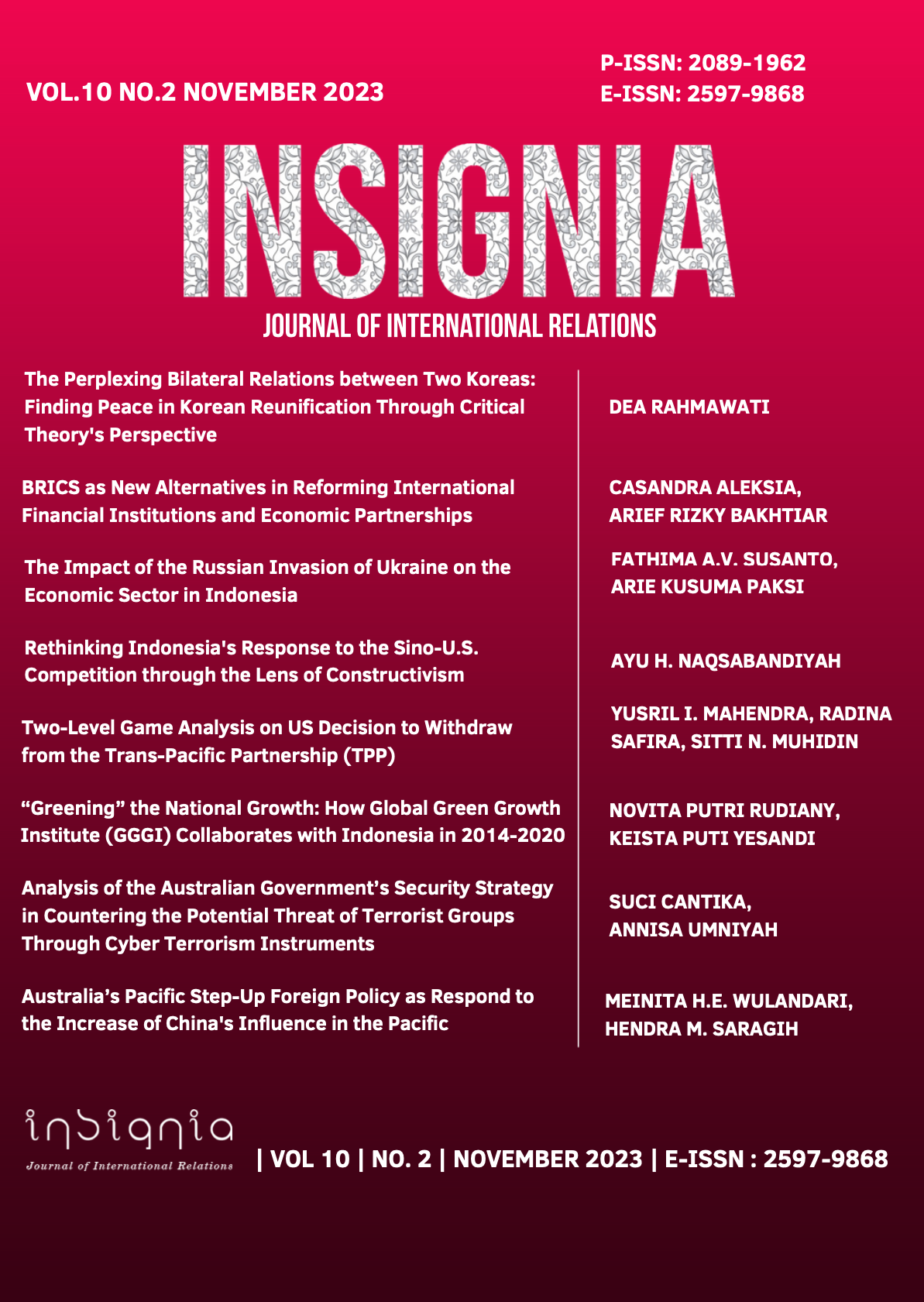Analysis of the Australian Government’s Security Strategy in Countering the Potential Threat of Terrorism Groups Through Cyber Terrorism Instruments
Abstract
This paper discusses the strategies adopted by Australia in dealing with and overcoming the violent acts of Cyber Terrorism. Since the terrorist attack on September 11, 2001 in the United States, countries in the world have assumed the existence of terrorist groups as a global threat. Globalization has enabled the terrorist groups to transform conventional media in the cyber world into the infamous cyber terrorism which they use as a propaganda instrument for recruitment, providing logistics, training, forming paramilitaries, planning, carrying out attacks, hiding, and funding. This paper discussed the concept Australian national security which has developed beyond military. The concept of security according to the non-traditional approach is emphasized on the security interests of non-state actors (non-state actors). The present research used descriptive qualitative research, employing literature review or library research for data collection. The results found that the Australian government remains vigilant against cyberterrorism through law enforcement and international cooperation. The Australian government has stipulated the Criminal Code Act 1995 part 5.3 to fight against the acts of terrorism. In addition, to increase domestic skills in cyberspace, The Australian government also establish Australia's Cyber Security, through which the Australian Cyber Security Centre (ACSC) founded Joint Cyber Security Centres (JCSCs), AustCyber, the Australian Cyber Security Growth Network, and the Cyber Security Cooperative Research Centre. and. Australia is also committed to supporting and maintaining international mechanisms that promote stability and to working with partners on a voluntary basis to prevent and respond to threats, including cyber terrorism.
Keywords: Australia, cyber terrorism, national security
References
Ansari, R. (2019). Politik Sekuritisasi Kontra-Terorisme Global Australia Pasca 9/11 Hingga Terpilihnya Kembali Perdana Menteri Howard. Jurnal Asia Pacific Studies, 3(2), 171-180.
Australia Cyber Security Centre. (2022). “Annual Cyber Threat Report July 2021-June 2022.” Accessed from https://www.cyber.gov.au/ab out-us/reports-and- statistics/acsc-annual-cyber- threat-report-july-2021-june- 2022.
Australian Government. (2023). “Australia's Counter-Terrorism Laws.” Accessed from https://www.ag.gov.au/nationa l-security/australias-counter- terrorism-laws.
Australian Governments. (2020). “Australia's Cyber Security Strategy 2020.” Accessed from https://www.homeaffairs.gov.a u/cyber-security- subsite/files/cyber-security- strategy-2020.pdf.
A.S, B..A.A. & Fitriana, I. (2017). Cyberterrorism: An Asymmetric Communication Challenge for National Defense. Jurnal Komunikasi, 2(1), 1-15.
Bachtiar, Y. A., Perkasa, D.H. & Sadikun, R. (2016). The Role of Media in Propaganda. Komunikologi: Jurnal Ilmiah Ilmu Komunikasi, 13(2), 78-89.
Dina, H. A. I. (2021). Aksi Cyber-Terrorism di Amerika Serikat dalam Perspektif Keamanan Global. Global & Policy, 9(2), 130-134.
Department of Foreign Affairs and Trade. (2023). “Agreement Between Australia and the Republic of Indonesia on the Framework for Security Cooperation. “ Accessed from http://www.austlii.edu.au/ au/other/dfat/treaties/ATS/2008/3.html.
Federal Register of Legislation. (1995). “Criminal Code Act 1995.” Accessed from https://www.legislation.go v.au/Details/C2019C00043.
Hardiana, I. M. Y., Sushanti, S., & Fasisaka, I. (2014). Kerjasama Kontra-Terorisme antara Australia dengan Indonesia dalam Menanggulangi Ancaman Terorisme di Indonesia (2002-2008). DIKSHI (Diskusi Ilmiah Komunitas Hubungan Internasional), 1(2), 1-15.
Hughes, C. (2023). “Internet User As A Percentage Of The Total Population Australia 2015-2022.” Accessed from https://www.statista.com/statistics/680142/australia-internet-penetration/#:~:text=The%20share%20of%20the%20Australian,22%20million%20subscribers%20in%202022.
Latuheru, M. N., & Irwansyah, (2019) Aplikasi Traveloka Sebagai Bentuk Konstruksi Sosial dalam Dunia Siber. Jurnal Kajian Media, 3(2), 79-88.
Madjid, Y. R. (2021). Cyber Terrorism Challenges: The Need for Global Mutual Legal Assistance for Universal Criminal Jurisdiction. Yustisia Journal of Law, 10(3), 388-414. https://doi.org/10.20961/yusti sia.v10i3.
Moleong, L. J. (2017). Metode Penelitian Kualitatif. Bandung: PT. Remaja Rosdakarya.
Nedim, U. (2023). “Which Groups Does Australia List as Terrorist Organizations?” Accessed from https://www.nationalsecurit y.gov.au/what-australia-is- doing/terrorist- organisations/listed- terrorist-organisations.
Payani, N. L. B. (2016). Pengaruh Serangan 9/11 Terhadap Perkembangan Dinamika Keamanan Internasional. Andalas Journal of International Studies, 5(1), 28-41.
Sarinastiti, E. N. & Vardhani, N.K. (2018). Internet dan Terorisme : Menguatnya Aksi Global Cyber-Terrorism New Media. Jurnal Gama Societa, 1(1), 40-52. https://doi.org/10.22146/jgs.34048
Simorangkir, B. (2020). Expanding the Agenda for National Security Studies: Politics, Law and Strategy. Jurnal Diplomasi Pertahanan, 6(3), 47-57.
Sindi, H. Q. (2016). Analisis Perilaku Kejahatan Terorisme Osama Bin Laden. Journal of International Relations Universitas Diponegoro, 2(4), 93-98. https://doi.org/10.14710/jirud.v2i4.13413
Sukoco, A., Syauqilah, M. & Ismail, U. A. (2021). Media, Globalisasi, dan Ancaman Terorisme. Journal of Terrorism Studies, 3(2), 1-15. https://doi.org/10.7454/jts.v3 i2.1039
Wattimena, R.A.A. & Arifin, B. (2018). Beyond Terrorism: A Comprehensive Approach to Understanding and Countering Terrorism. Mandala Journal of International Relations, 1(1), 38-55.
Weiman, G. (2004). “Cyberterrorism How Real Is The Threat?” United States Institute of Peace. Accessed from https://www.usip.org/sites/default/files/sr119.pdf.
Yunus, S. (2022). “For First Time Since 2014, Australia Lowers Terror Threat Level.” Tempo. Accessed from https://dunia.tempo.co/read/1661970/pertama-kali- sejak-2014-australia- menurunkan-tingkat- ancaman-teror.

This work is licensed under a Creative Commons Attribution-NonCommercial-ShareAlike 4.0 International License.
1. The author retains copyright and grants the journal the right of first publication with the work simultaneously licensed under a Creative Commons attribution license that allows others to share the work within an acknowledgment of the work’s authorship and initial publication of this journal.
3. Authors are permitted and encouraged to post their work online (e.g., in institutional repositories or on their websites) before and during submission, as it can lead to productive exchanges and earlier and more extraordinary citations of published works.


.png)


